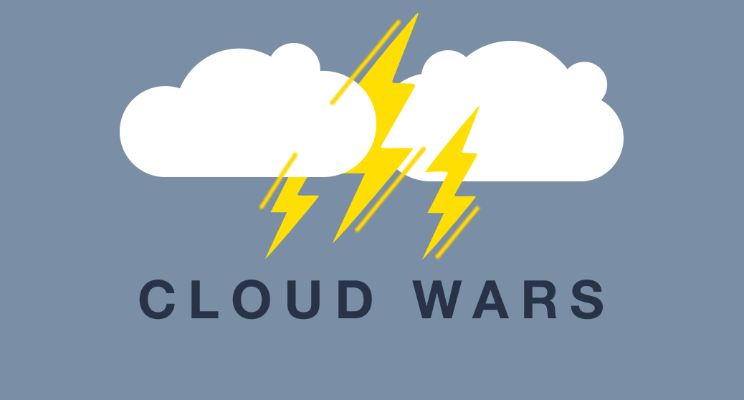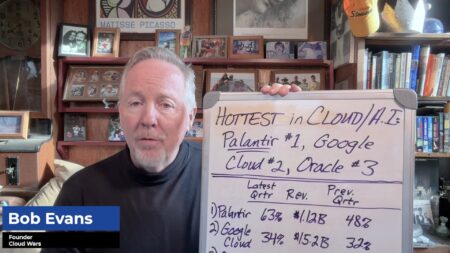To get a sense of how big, fast-growing and disruptive Amazon’s cloud business is, try this: just its revenue growth in 2018—not its total revenue, but rather the $8-billion increase from 2017’s $17.5 billion to last year’s $25.6 billion—would make it the fifth-largest enterprise cloud vendor in the world.
That excellent ongoing growth, Amazon’s longtime and accelerating innovations in the cloud industry, and its bold decision to try to redefine enterprise databases in the cloud all combine to make longtime Amazon Web Services visionary and leader Andy Jassy our CEO of the Year in the Cloud Wars. (Last year’s CEO of the Year was Microsoft’s Satya Nadella.)
While I contend that Amazon—in spite of its uninterrupted record of stellar performance in revenue, product innovation, breadth of ability to meet customer needs, brand recognition—is the #2 player in the Cloud Wars behind Microsoft, there is no dispute about the company’s highly disruptive and positive impact on the business world across Jassy’s entire 15-year run as the leader of AWS.
Check out the company’s relentlessly steep revenue growth as depicted in this great chart from Statista, showing results from Q1 2014 on the far left to Q4 2018 on the far right:

And in the midst of that growth, Jassy led an extremely high-stakes gambit to move the entire Amazon corporation—not just the AWS cloud unit, but the entire $233-billion empire—off of the industry-leading Oracle Database and onto two of Amazon’s own databases. If that massive gamble pays off, it will rock the tech business to its core and open up another new and potentially huge growth market for Jassy and company, as I analyzed last month in Amazon Versus Oracle: The Battle for Cloud Database Leadership.
In a recent interview with CNBC’s Jon Fortt, Jassy described in detail his company’s internal database transformation and the reasons behind his belief that a generational and sweeping disruption is coming to the database market in the cloud.
Jassy began with a fairly restrained but clearly pointed jab at a question about public claims Oracle founder Larry Ellison has made: that Amazon would never be able to generate the technological capabilities to rip and replace the Oracle databases that have underpinned Amazon’s operations for more than 20 years.
“Anybody who has spent time looking at the cloud, or is using the cloud, will take those comments with a grain of salt,” Jassy told Fortt. “Sometimes facts are useful because facts are still a good thing—and if you look at the facts, by the end of 2018, 88% of the databases in Amazon that were running Oracle will be off of Oracle, and will instead be running Amazon Dynamo DB or Amazon Aurora. And 97% of the mission-critical databases will be off of Oracle and will be on Dynamo or Aurora.”
And the small outposts of Oracle Database still remaining will be gone soon, Jassy promised.
“On November 1, we turned off our Oracle Data Warehouse and moved it to (Amazon) RedShift. We’re virtually done moving away from Oracle on the database side, and by the end of 2019 or mid-2019, we’ll be done.”
And Jassy then delved into a line of thinking that played a huge part in my choice of him as the Cloud Wars CEO of the Year for 2018. Because the approach that Jassy and team are taking in their assault on Oracle’s massive installed base of database customers is precisely the approach that Oracle’s Ellison took more than 40 years ago when he flipped the tables on the incumbent by choosing to compete on entirely new terms.
Asked if the era of the “one-size relational database” is over, Jassy replied, “Yeah. That ship has sailed. If you look out over the last 20 years when people were running relational databases for everything, it made sense with ERP or CRM or e-commerce applications where there were complicated ad-hoc queries and joins.
But as we now so clearly see, everything has changed in the intervening two decades, and Amazon believes that today’s cloud-based and big-data-driven businesses require a range of specialized and even boutique database solutions rather than a single traditional approach.

“In those days, the applications tended to have gigabytes of data and occasionally terabytes,” Jassy said in the CNBC interview. But today, terabytes are commonplace and many applications and workloads run into tens or hundreds of petabytes.
“And that’s a very different requirement,” he said, citing AWS customers Lyft and AirBnB as examples.
Plus, in our increasingly digital world, the need for speed is paramount—and to deliver that speed, data has to be managed and manipulated in new and better ways.
“You have some apps that say, ‘I can’t deal with millisecond latency; I need microsecond latency,’” Jassy told Fortt.
“So there are different databases for different purposes, and the days of using a single type of database to solve all the problems is gone. You can do it in the same way you can build a house with a hammer—you can put up all the walls and the roof with a hammer, but that’s not really an advisable strategy, and the same thing is true with databases.”
But as compelling as the competition in databases with Oracle will be, the Moby Dick to Jassy’s Ahab is unquestionably Microsoft, whose hypergrowth across its commercial cloud business has pushed its enterprise-cloud revenue almost 20% higher than that for AWS.
And clearly, the spotlight will continue to shine brightly on Jassy as he confronts those two marketplace dynamics, which I placed at the very top of my list of The Top 10 Cloud-Computing Stories of 2018.
In Jassy’s interview with Fortt, the AWS leader spoke a couple of times about how no other cloud vendor can match the depth and breadth of what Amazon can offer.
Referring to a recent huge win Amazon had with customer Korean Air, Jassy told Fortt, “They have a lot of ideas on how they want to change that customer experience, and AWS just has a lot more capability than anybody else by a large margin that will allow them to invent at a faster rate. And, I think they wanted to invent but also in a cost-effective fashion and they realized they could save a meaningful amount of money with AWS versus what they were doing before.”
Compare that with what Microsoft CEO Satya Nadella said a couple of weeks ago on Microsoft’s earnings call when asked to explain Microsoft’s recent run of big-customer wins, a question I explore in some depth in my recent piece called Why Microsoft Is #1 in the Cloud: 10 Key Insights:
“When I look at how every business is becoming a digital business and then I map that opportunity to our capabilities, we just have the broadest platform of anyone in the tech sector to be able to really help every customer in every country become that digital business,” Nadella said on the earnings call. “And on top of that, we have the business model that aligns with them and their interests and their trust.”
So there you have it: the CEO of the Year from 2017 and the CEO of the Year from 2018 each claiming that his company has more of what digitally minded businesses want and need.
And that, my friends, will surely be the defining battle in the Cloud Wars in 2019.
For now, however, congratulations to Amazon Web Services CEO Andy Jassy for a fabulous 2018 and the recognition he and his company clearly deserve.
Subscribe to the Cloud Wars Newsletter for twice-monthly in-depth analysis of the major cloud vendors from the perspective of business customers. It’s free, it’s exclusive, and it’s great!









